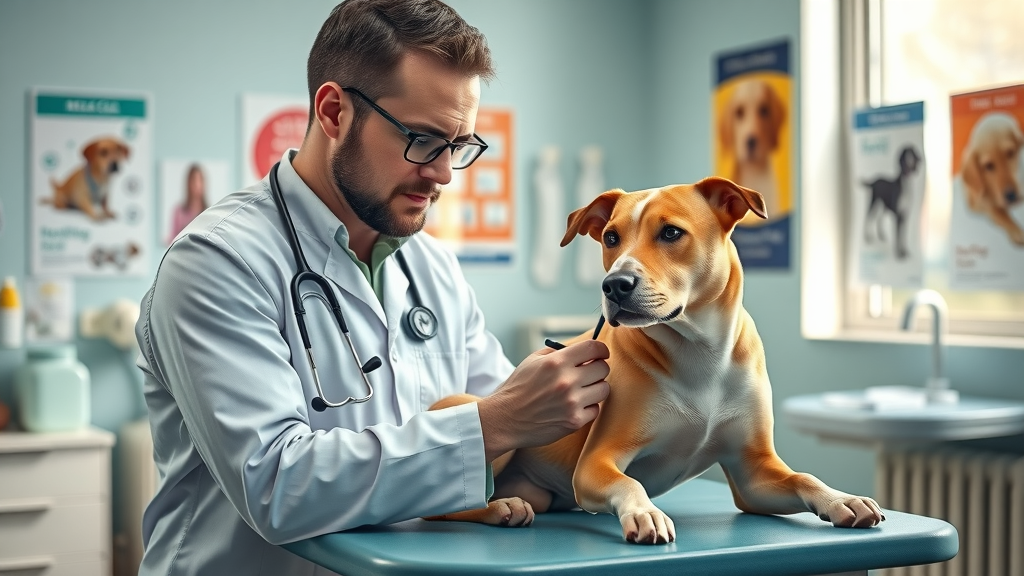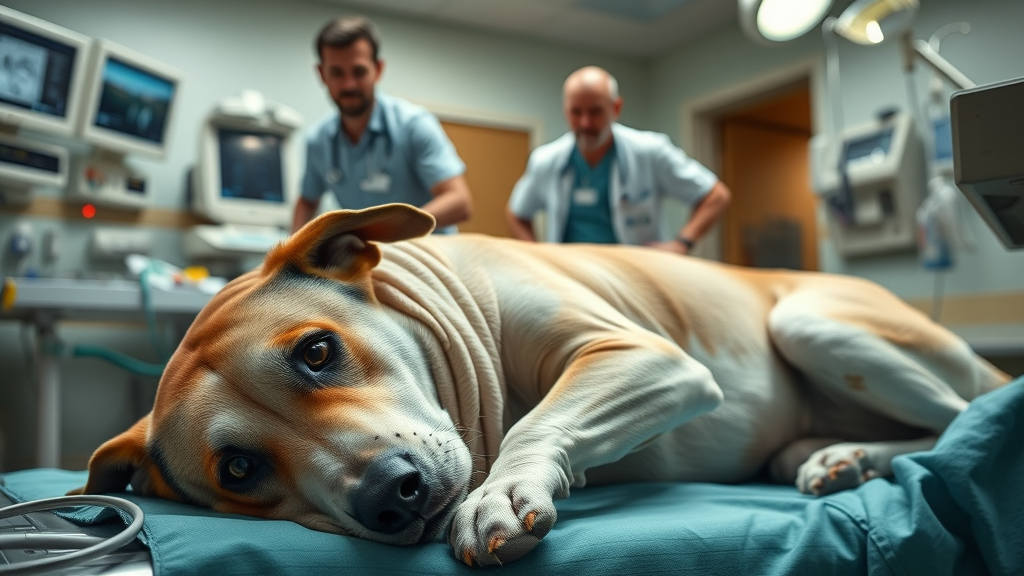Did you know that nearly 40% of emergency vet visits for dogs are due to vomiting or digestive problems? Understanding the answer to 'why is my dog throwing up?' is crucial for your pet’s health and well-being.
Understanding Why Is My Dog Throwing Up? Common and Serious Causes of Dog Vomiting
- Learn the urgent and common reasons behind dog vomiting
- Discover when dog vomit signals an emergency
- Recognize the differences between acute and chronic vomiting in dogs
- Find out how to respond effectively for your dog’s health

If you’re a dog owner, you know that a healthy pup can suddenly become sick, leaving you asking: why is my dog throwing up? Dog vomiting can happen for many reasons, from minor food reactions to real emergencies. Every dog throws up at some point, but knowing the difference between a harmless episode and a threatening condition can save your dog’s life. Common culprits include eating too fast, sudden diet change , or sneaking human food, but serious causes can range from toxic substance ingestion to organ problems. Your dog’s health depends on your ability to spot these differences and respond fast. This section will help every pet parent learn the typical and urgent causes behind dog vomiting and when to call your vet.
Why Is My Dog Throwing Up? Recognizing Types, Colors, and Urgent Warning Signs
Understanding the type of vomit your dog produces is critical for quick action. Dog vomit comes in many colors and textures, each hinting at different health concerns. For instance, yellow vomit often means your pup has an empty stomach and is vomiting bile, while green could signal grass ingestion or a more dangerous toxicity. White foam can mean irritation of the digestive system , and red or brown may point to internal bleeding, an actual medical emergency. Recognizing these signs helps dog owners separate common causes from urgent crises.
Another important factor is the presence of other symptoms along with vomiting in dogs. Look out for things like severe lethargy, collapse, blood in vomit or stool, frequent vomiting, or signs of dehydration (dry gums, sunken eyes, skin that doesn’t snap back). If these occur, call your vet immediately— dog vomiting can escalate quickly and sometimes, minutes count.
Decoding Dog Vomit: What Different Colors Mean for Vomiting in Dogs
- Yellow vomit: Empty stomach bile or pancreas issues
- Green vomit: Possible ingestion of grass or toxins
- White foam: Gastrointestinal irritation
- Red or brown: Blood or internal bleeding—urgent
Dog owners often worry when they see oddly colored vomit. Yellow vomit is usually related to your dog’s bile, especially if their stomach is empty. Green vomit may result from eating grass, but could also signal a toxic substance. If you see white foam, think gastritis or irritation, and red or brown—especially if it resembles coffee grounds —often means blood is present due to gastrointestinal bleeding. Each type of vomit tells a story, and in some cases, urgent veterinary attention is required.
Warning Signs: When To Call Your Vet Immediately If Your Dog Is Vomiting
- Severe lethargy or collapse
- Blood in vomit or stool
- Continued vomiting over 24 hours
- Signs of dehydration
If your dog shows continued vomiting that lasts more than a day, has blood in any vomit or stool, or appears extremely tired, don’t wait— call your vet or head to the emergency vet right away. Dehydration is also a severe risk when dogs vomit repeatedly and can develop fast, especially in smaller breeds or puppies. Look for dry or sticky gums, lack of energy, and loss of skin elasticity as signs your dog needs urgent help. Remember, your quick action could make all the difference.
| Vomit Color/Contents | Possible Causes | Urgency Level |
|---|---|---|
| Yellow | Bile, empty stomach, acid reflux | Moderate/Monitor |
| Green | Grass, possible toxicity | Moderate/High |
| Red/Brown | Blood, GI bleeding | Emergency |
| White Foam | Gastritis, stomach irritation | Moderate/Monitor |
Acute Vomiting in Dogs: Sudden Episodes and What To Do
Acute vomiting in dogs is a sudden, unexpected episode of throwing up—and it can be frightening for even experienced dog owners. It often happens without warning, sometimes after your dog eats something odd or gets into the trash. It’s crucial to know the triggers for acute vomiting , how to keep your dog safe at home, and when the episode signals an emergency. Immediate attention can make all the difference between a simple upset stomach and a life-threatening situation.
Not all dogs vomit for the same reasons. Some have sensitive stomachs and react quickly to a diet change; others may get sick after eating too much or too fast. Curious dogs might scavenge garbage or chew on houseplants, and these behaviors can lead to sudden, severe vomiting that sometimes requires calling your vet. Recognizing patterns and responding promptly protects your dog’s health.
Why Acute Dog Vomiting Needs Fast Attention
While minor vomiting may sometimes resolve on its own, acute vomiting requires that dog owners watch for red flags. Dogs—especially puppies, seniors, and smaller breeds—can rapidly become dehydrated or experience dangerous drops in blood sugar. If vomiting starts abruptly after a diet change, or you suspect ingestion of medicine, chemicals, or other toxins, err on the side of caution and contact your veterinarian promptly.
Timely observation helps differentiate between a mild digestive upset and a medical emergency. Monitor your dog for accompanying signs, such as refusal to eat, continued vomiting, or unusual tiredness. Speed is key; the quicker you act, the better outcome for your furry friend.
Top Triggers: Dog Food, Toxins, and Sudden Diet Changes
Major causes of acute vomiting in dogs include new dog food brands/formulas, abrupt feeding of human food , or eating something toxic such as chocolate, xylitol (a sugar substitute), or certain common plants. Even a morsel of a dropped grape or onion can be dangerous.
Sometimes, a change in dog food is all it takes to upset your dog’s digestive system. Sudden shifts don’t give the gut time to adjust, leading to vomiting and diarrhea. Ingestion of non-food objects, medications, or spoiled foods from the trash are also top offenders. Always monitor your pet closely after introducing anything new to their diet or environment.

Should I Take My Dog to the Vet for Acute Vomiting?
If your dog’s vomiting is persistent, involves blood, is accompanied by other severe symptoms, or you think a toxin or foreign object is involved, take your dog to the vet immediately. Missing these signs can be life-threatening.
For one-off vomiting with no other symptoms, monitor your pet, withhold food for 6–12 hours, then reintroduce small amounts of bland food. But if in doubt—or if your dog is very young, old, or has health issues—play it safe and consult a veterinary expert.
Chronic Vomiting: Why Is My Dog Throwing Up Regularly?
Chronic vomiting is when a dog throws up repeatedly over several days, weeks, or even longer. Unlike acute vomiting, this pattern is a bigger red flag and suggests an underlying health issue that needs investigation. If you notice your dog vomiting small amounts, skipping meals, or showing weight loss, don’t ignore these clues.
Chronic vomiting can result from food allergies, chronic pancreatitis, inflammatory bowel disease, kidney or liver disorders, or even certain cancers. If vomiting becomes a regular occurrence, a thorough vet check is required for proper diagnosis and treatment, keeping your pup healthy.
Detecting Persistent Patterns: Is This Vomiting in Dogs a Red Flag?
A vomiting episode here or there can be normal, especially if your pet occasionally eats grass or skips a meal. However, if the behavior is ongoing—more than a couple of times a week, or over several days—it’s time to worry. Watch for weight changes, dull coat, or lethargy, which often accompany chronic vomiting .
Consistent patterns, such as vomiting after the same snack, during stressful events, or at specific times, help your veterinarian narrow down possible chronic diseases or intolerances. Keep a diary with details (type of vomit, frequency, food, and activities) to share with your vet.
Underlying Medical Causes: Dog Vomiting Linked to Chronic Disease
Chronic vomiting in dogs is sometimes caused by deeper medical conditions such as kidney disease, liver disorders, diabetes, food allergies, inflammatory bowel disease , or even some cancers. A veterinarian might recommend bloodwork, allergy testing, or imaging studies if these are suspected.
Digestive system problems, poor nutrient absorption, or autoimmune triggers can all be at play, making early intervention critical. Some cases may require a prescription diet, medication, or long-term management roles.

When to Consult Your Veterinarian for Chronic Dog Vomit
Dog owners should contact their vet if vomiting is frequent, occurs with other symptoms (like diarrhea, weight loss, behavior changes, weakness), or persists beyond 48 hours. Remember, when in doubt, a call to the veterinarian is always safer than risking your dog’s health.
Waiting too long can transform a manageable condition into a severe emergency. Keep an open line with your vet and bring detailed records of vomiting episodes to every appointment.
Dog Vomit or Regurgitation? How To Distinguish Vomiting in Dogs
Many pet parents confuse vomiting in dogs with regurgitation. Understanding the difference helps you and your vet find the right diagnosis and treatment plan.
Vomiting is an active process—your dog might retch, vomit forcefully, and act uneasy before or after. Regurgitation, however, is passive: the dog suddenly expels undigested food, usually without warning or distress.
Key Differences: Vomiting versus Regurgitating
Vomiting often includes bile, digested food, or foam and is usually preceded by drooling, licking lips, or heaving. Regurgitation typically brings up undigested, tubular food and is quieter. The location (from stomach/small intestine versus esophagus) also differs.
Telling your vet whether the episode was vomiting or regurgitation directs them toward checking specific medical systems—gi tract or esophagus, respectively.
Why Recognizing the Difference Matters for Your Dog’s Health
Accurately reporting if your dog is vomiting or regurgitating influences the path to recovery. Some causes—like esophageal disease—won’t improve with bland diets or standard vomiting remedies.
The health of your dog relies on careful observation. If unsure, take a video to show your vet, and always be clear about what you observed.
Dog Vomiting and Diet: Could Dog Food Be to Blame?
Diet is a major factor in why dogs vomit . Dog food with new ingredients, poor quality, spoilage, sudden changes, or hidden allergens can quickly upset the digestive system.
If switching dog foods (or accidentally offering human food ), do so gradually. Consistency is key—abrupt change leads to stomach distress, and returning to a familiar diet may resolve symptoms.
Allergies, Intolerances, and Ingredients to Watch for in Dog Food
Dog food allergies and intolerances are common culprits. Wheat, gluten, artificial dyes, high-fat meats, and certain preservatives can irritate your dog’s digestive system, triggering vomiting and diarrhea.
Watch how your dog reacts after eating and consult your vet about elimination diets or allergy testing if you suspect a recurring pattern. For some dogs, finding the right protein (chicken, beef, fish, lamb) makes all the difference.

Feeding Schedules: Preventing an Empty Stomach and Dog Vomiting
Going too long between meals puts some dogs at risk for yellow bile vomiting due to an empty stomach . These episodes often happen first thing in the morning. To avoid it, feed your dog smaller, more frequent meals—morning, midday, and evening—rather than a single large serving.
Adjust feeding times to suit your dog’s age, breed, and lifestyle, but never let them go more than 12 hours without food unless your vet instructs otherwise.
Safe Diet Adjustments When Your Dog Is Vomiting
If your dog’s vomiting isn’t an emergency, offer a brief fasting period (6–12 hours), then try a bland diet —plain chicken and rice, or veterinarian-approved food. Avoid treats, table scraps, and fatty foods.
Always have fresh water available. Resume your dog’s normal diet only if they stop vomiting and act normal. Any recurrence may warrant a call to your vet.
Critical Situations: When Dogs Vomit Due to Emergency Causes
Some vomiting requires immediate veterinary attention. Dogs can develop life-threatening conditions from foreign objects, chemical toxins, or serious illnesses like bloat and pancreatitis.
It is vital to act quickly if your dog vomits and shows additional signs of distress—delayed action in critical scenarios leads to shock, organ damage, or even death.
Foreign Bodies, Toxins, and Life-Threatening Illnesses
Dogs love chewing, but swallowing toys, bones, socks, or household objects can block the digestive tract, causing intense pain and persistent vomiting. Poisonous foods—grapes, chocolate, onions—also lead to rapid decline.
Seek immediate help if you suspect your dog swallowed something dangerous. Sometimes, x-rays or emergency surgery are the only answers.

Bloat and GDV: Urgent Symptoms Every Dog Owner Should Know
"If your dog vomits and appears bloated, time is critical—seek emergency care immediately." — Emergency Veterinary Specialist
Bloat (or gastric dilatation-volvulus, GDV) is a deadly condition where the stomach twists; symptoms include repeated, non-productive vomiting, a distended belly, restlessness, and collapse. Bloat kills within hours, so rush to the emergency vet if you see these signs.
Recognizing Dehydration and Shock After Dog Vomiting
After severe vomiting, your dog can lose fluids and electrolytes, leading to dehydration and possibly shock. Skin that doesn’t spring back, weak pulse, or gray gums signal a dire situation.
Give water if tolerated, but if your dog cannot keep fluids down, seek immediate veterinary attention to avoid a life-threatening crisis.
How Veterinarians Diagnose Vomiting in Dogs
Determining the exact cause of vomiting in dogs requires professional evaluation. Vets look at your dog’s history, diet, and symptoms, then use advanced diagnostic tests to rule out critical problems.
The thoroughness of the workup ensures you get a clear answer—the right treatment depends on knowing if the cause is mild or life-threatening.
Common Tests: Bloodwork, X-rays, and Ultrasound
Vets may use blood tests to check for organ dysfunction (kidneys, liver), metabolic problems, or infection. Abdominal x-rays and ultrasound help find foreign objects (toys, bones), cancer, or twisted bowels (as seen in bloat).
For chronic cases, testing may extend to allergy panels, fecal analysis, and sometimes endoscopy to look inside the digestive tract.
How Your Vet Determines If Dog Vomit Is a Medical Emergency
The presence of blood, repeated vomiting, collapse, or inability to keep fluids down all signal a medical emergency . Vets will triage these cases, sometimes providing IV fluids, anti-nausea medication, or even surgery on the spot.
Share a thorough history—including a sample of the vomit if possible—to speed up diagnosis and care.
Immediate Home Care: What To Do If Your Dog Is Vomiting

Safe At-Home Steps to Help Your Vomiting Dog
If vomiting occurs without severe symptoms, remove food for 6–12 hours but keep water available. After fasting, offer a small amount of bland food (white rice and boiled chicken) and gradually increase portions if your pet improves.
Document the color, contents, and timing of vomit to help your vet later. Wash hands and clean surfaces thoroughly to avoid spreading germs. Never give human medicine unless directed by your vet.
What NOT to Do When Your Dog Vomits
Don’t let your dog eat or drink large amounts too soon after vomiting. Avoid forcing food, giving your dog over-the-counter medications, or ignoring persistent or worsening symptoms.
Never punish or scold your pet—vomiting isn’t their fault, and extra stress can make things worse. If unsure, always call your vet.
Prevention: How To Reduce Vomiting In Dogs
- Tips for feeding and hydration routines
- Avoiding common hazards at home
- Regular vet visits and early warning signs
- Use slow-feeder bowls to prevent fast gulping
- Monitor access to trash, toxins, and plants
- Stick to consistent diets and feeding times
Preventing vomiting starts at home—feed smaller, more frequent meals and discourage gulping with specialized bowls. Secure all trash cans and remove household toxins and plants from your pup's reach.
Regular vet visits and early intervention keep your dog healthy and happy, catching diet or health issues before they escalate.
When to worry about a dog throwing up?
When to worry about a dog throwing up? Answered
Worry if your dog vomits multiple times in 24 hours, passes blood, acts weak or collapses, becomes severely dehydrated, or you suspect poison ingestion. Persistent or recurrent vomiting in puppies or older dogs is extra concerning—seek veterinary attention promptly.
Always err on the side of caution if your dog shows additional symptoms or behaves unusually.
Vomiting in dogs: Severity, frequency, and danger signs
It’s normal for a dog to vomit on occasion, especially after eating grass or new treats. But frequent, severe, or projectile vomiting, especially with blood, coffee ground appearance, or accompanied by lethargy, points to a more dangerous problem. These danger signs should prompt an urgent call to your vet.
What do I give my dog for vomiting?
What to give dogs for vomiting? Answered
If your dog vomits but shows no warning signs, try fasting for 6–12 hours, then offer small meals of a bland diet (boiled chicken and white rice). Avoid giving your dog commercial treats or table scraps, and ensure constant access to water.
Never give human medicine, like anti-nausea pills or painkillers, unless specifically prescribed by your vet.
Safe foods, fasting, and when to see the vet
Bland diets are safest—but only if your dog’s symptoms are mild and they are otherwise healthy. If vomiting continues, a small amount of food is thrown up each time, or new symptoms develop, contact your vet immediately.
What does concerning dog vomit look like?
What concerning dog vomit looks like? Answered
Be concerned if you see red/brown (bloody), coffee ground, black, or persistent green vomit. Vomit with strange odors, unusual textures, or containing pieces of objects that shouldn’t be ingested are also serious signs.
Photos, descriptions, and when to call your vet
If able, take a photo of the vomit to show your vet. Note if it is frothy, watery, filled with undigested food, or contains blood. This can help your vet identify gastrointestinal bleeding, toxic ingestion, or foreign object emergencies. Always call your vet if unsure.
What if my dog is vomiting but acting normal?
My dog is vomiting but acting normal. Should I worry?
Occasional, isolated vomiting with no other symptoms and a still-active, happy pup may not need an urgent vet visit. Continue to watch your dog for changes in habits, appetite, or energy.
If vomiting recurs, becomes frequent, or your pet’s behavior changes, reach out to your vet for advice.
Occasional vs. frequent vomiting in healthy dogs
A single episode in a playful, alert pet is typically not dangerous. Recurrent or frequent episodes, even if your dog appears normal in between, suggest an underlying problem that needs vet evaluation.
Frequently Asked Questions on Why Is My Dog Throwing Up?
- Why does my dog vomit yellow liquid? Vomiting yellow liquid usually means bile, released from an empty stomach or as a result of mild acid reflux. Feed your pup small, frequent meals to reduce this.
- What are the most common causes of vomiting in dogs? Common causes include dietary indiscretion (eating trash), rapid eating, allergies, stomach infections, toxin exposure, and sudden diet changes.
- When should I seek vet care for dog vomiting? Seek care if there’s blood in the vomit, repeated vomiting, lethargy, or signs of pain and dehydration. Better safe than sorry!
- Can dogs vomit because of stress or anxiety? Yes, stress and anxiety can upset your dog’s digestive system, leading to occasional vomiting—especially in sensitive breeds.
Practical Tips for Handling Dog Vomit at Home
- Wear gloves and use safe cleaners
- Document frequency and appearance of vomit
- Keep sample for vet if unusual or severe
Essential Takeaways: What Pet Owners Should Remember About Why Is My Dog Throwing Up?
- Dog vomiting can have severe causes—don’t ignore danger signs
- Monitor frequency, color, and your dog’s behavior
- Vet care is crucial for persistent or urgent symptoms
"Err on the side of caution—if you’re worried about why your dog is throwing up, consult your vet." —Veterinary expert
Ready for More Trusted Pet Advice?
- We can’t teach your dog to sit — but we can deliver great pet advice every month. 🐕 Subscribe to the newsletter and fetch some fun!
Act fast when your dog vomits: monitor symptoms, adjust food safely, and contact your vet when in doubt—your prompt response keeps your dog healthy and safe.
Understanding why your dog is vomiting is crucial for their health. The article “Dog Vomiting: Causes, Diagnosis, and Treatment” by the American Kennel Club provides comprehensive insights into both acute and chronic vomiting in dogs, detailing potential causes and when to seek veterinary care. ( akc.org ) Additionally, “Dog Vomiting: Causes, Treatment, and Related Symptoms” from WebMD offers valuable information on common triggers and associated symptoms, helping pet owners recognize when vomiting may indicate a more serious condition. ( webmd.com ) If you’re serious about understanding and addressing your dog’s vomiting, these resources will provide you with essential knowledge and guidance.
 Add Row
Add Row  Add
Add 




Write A Comment